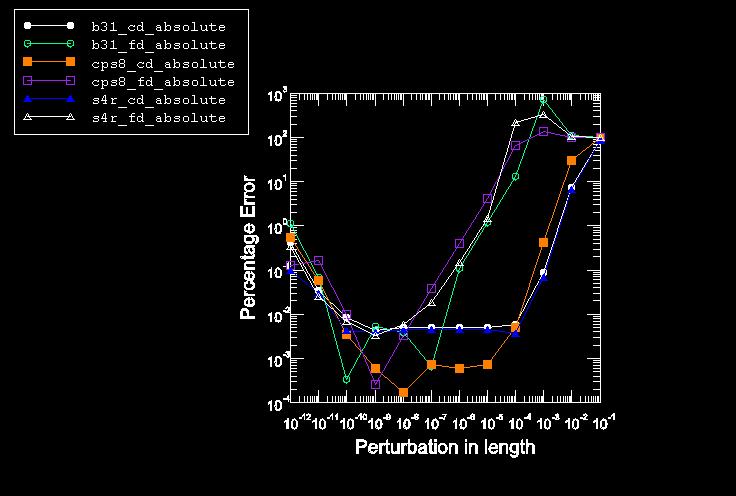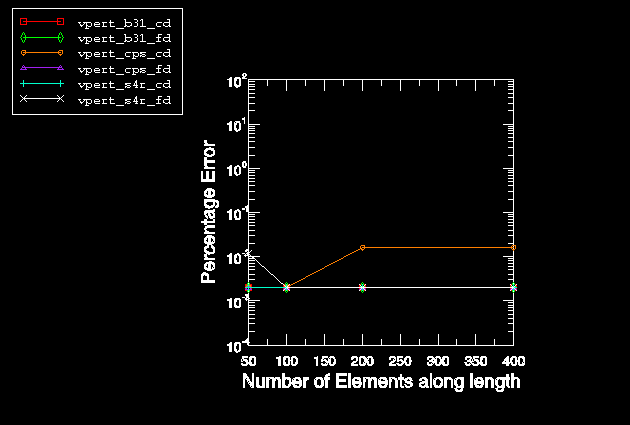Based on Euler-Bernoulli beam theory the sensitivity of the tip
displacement, ,
with respect to the length, ,
of the beam for a cantilever with end load
is given by
where
is the modulus of elasticity and
is the moment of inertia.
The semianalytical method is based on perturbing the design parameter,
,
and using a differencing technique to approximate the sensitivities. For this
problem the size of the perturbation in L yielding the
most accurate tip displacement sensitivity
can be determined by computing the error
over a range of perturbation sizes. The results for such an exercise using
forward differencing and central differencing are plotted in
Figure 1
for the coarsest meshes. The behavior of these results is typical: to the left
of the “optimum” perturbation size the error increases due to round off, or
cancellation error; to the right of the optimum perturbation size the error
again increases but this time due to the truncation of higher-order terms in
the differencing formulae, known as truncation error.
To demonstrate the growth in truncation error with the number of elements,
perturbation sizes are chosen from the truncation region of the plot shown in
Figure 1
such that the errors in the computed sensitivities for the most coarse meshes
are acceptable (0.1%). This leads to perturbation sizes of 5 × 10−4,
1 × 10−3, and 1 × 10−3 for central differencing and 2 ×
10−7, 6 × 10−7, and 9 × 10−7 for forward
differencing for the CPS8, S4R, and B31 elements, respectively. These same perturbation sizes are then
used in sensitivity analyses for the refined meshes.
Figure 2
shows the growth in the percentage error in the computed sensitivities as the
number of elements along the length is increased. It is clear from these
results that the perturbation sizes yielding accurate results for a coarse mesh
may yield poor results for a more refined mesh because the truncation error
grows with mesh refinement. The truncation error can be controlled by proper
choice of the perturbation size. Indeed, if one chooses a perturbation size of
1 × 10−9, it can be seen from
Figure 3
that the growth in the error for both central differencing and forward
differencing is insignificant for all element types.
The default perturbation sizing algorithm in
Abaqus/Design
determines the perturbation sizes for each element, which are then used in a
central difference scheme to compute the sensitivities.
Table 1
shows the perturbation sizes chosen for the element that has the dominant
influence on the tip displacement sensitivity at various levels of mesh
refinement and the percentage error in the
Abaqus/Design
sensitivity solution. For each of the coarsest meshes the perturbation size
chosen by
Abaqus/Design
is in good agreement with the optimum for central differencing based on
Figure 1.
It can be shown that the sensitivities of the eigenvalues
()
and natural frequencies (f, in cycles/time) for a
cantilever beam are given analytically by
and ,
respectively. The frequency analysis is performed for the coarsest mesh, and
the default perturbation sizing algorithm is used for the sensitivity analysis.
By default, the algorithm determines the perturbation size based on the first
mode, and the same perturbation size is then reused for the remaining modes. To
force
Abaqus/Design
to obtain a new perturbation size for each mode, the
DSA solution controls can be used in the
frequency step with the sizing algorithm executed at every increment. The
sensitivities of the eigenvalues and eigenfrequencies for the first three
bending modes obtained with
Abaqus/Design
are compared to those obtained analytically and using the overall central
differencing method in
Table 2,
Table 3,
and
Table 4
for all element types. An optimum perturbation size of 1.0 ×
10−4L was obtained by trial and error for the
overall differencing method. An excellent agreement between
Abaqus
and overall central differencing method is seen. The advantages of using the
design sensitivity analysis capability in
Abaqus/Design
over the overall finite difference method are: (1) automatic detemination of
the perturbation size, and (2) reduced computational effort since the
sensitivities are computed in the same analysis as the natural frequency
extraction. The effort expended on recalculating the perturbation size for each
mode by selecting a sizing frequency of 1 produces virtually no difference in
the sensitivities, which are quite accurate with the default setting.


